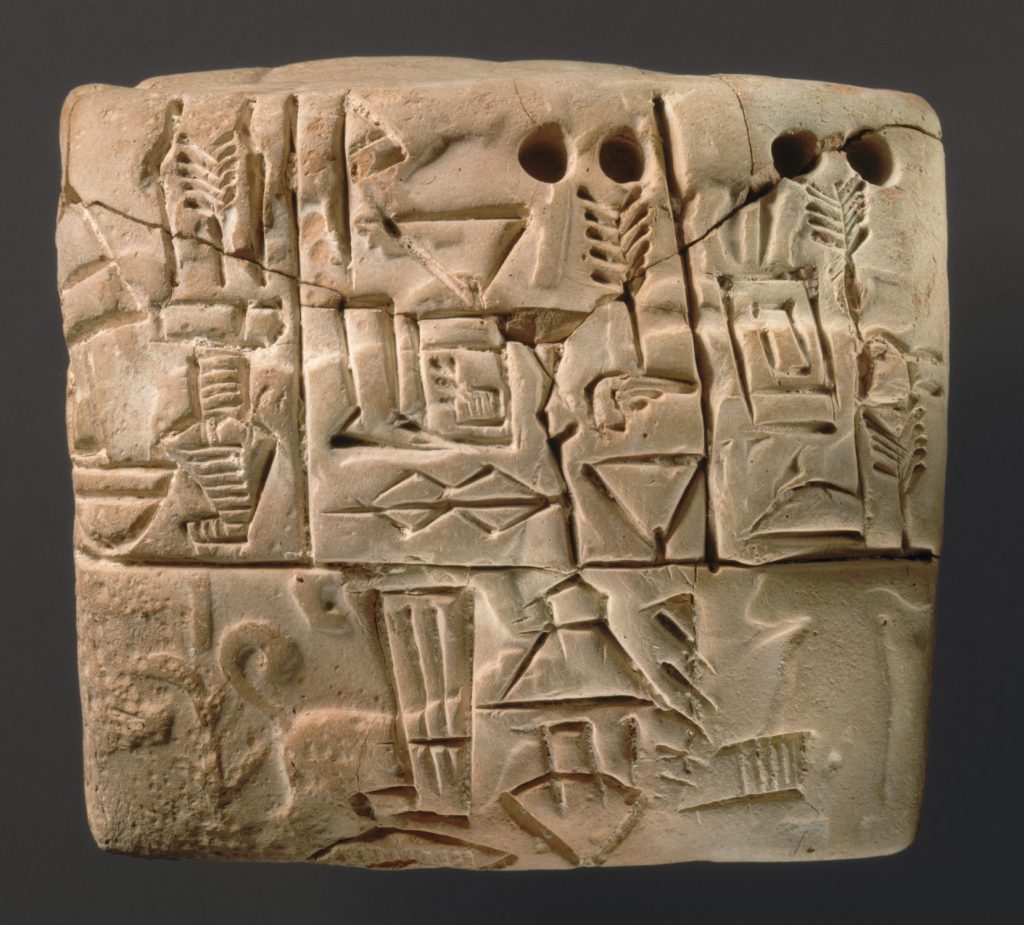Written language, which is perhaps taken for granted in the 21st century, was not common for early civilizations. Around 3,000 B.C.E. the first writing system was created by the Sumerians. The Sumerians developed their civilization in present day southern Iraq; they evolved into complex societies with large cities and centralized economies. The origin of their writing system developed to keep track of inventories of things produced, such as grain and livestock. From their records emerged the first written form of any language, called cuneiform.1
Literally meaning “wedged shaped,” cuneiform was written by using a stylist on a damp piece of clay. The clay was then baked to harden the inscription. Cuneiform developed from sounds of the Sumerian language. As time progressed, the writing became more and more complex. The forms went from being an inscription of an object, such as sheep, to more abstract representations of words, such as “the sheep walk to the temple.”2
Cuneiform is the oldest written language, but even the oldest language has its own origins. Recent archaeological research has found evidence for the origin of writing to be more complex than originally thought. Some recent discoveries of even older writing, called proto-cuneiform, were found in Syria and Turkey going back to the mid fourth millennium. These inscriptions are pictorial, much like hieroglyphs of Egypt. Many of them are decipherable, but most are so abstract that they cannot be identified with known objects. Some of these were even written on wood instead of clay. The tablets found from the Sumerian people are only a small fraction of the earliest writing. The Sumerian tablets are from the time when writing became standardized, as a result of rapidly growing Sumerian city-states. The need for a normalized way of writing with standard symbols that people could recognize was apparent, so they shifted from pictographs to a standard script. The script became the writing we know today as cuneiform, and it also became a new way to record other things, such as stories and legal codes.3

With the development of more complex writing came the first pieces of real literature. The Epic of Gilgamesh, written between 2150-1400 BCE, is the oldest known work of literature. The story comes from a long oral tradition that was passed by word of mouth for centuries. The development of cuneiform allowed the story to enter history as a written record. In addition to literature, legal writing emerged in the form of legal codes, such as the Law Code of Hammurabi, created sometime between 1794-1750 BCE. The Code of Hammurabi has almost three hundred laws that applied to the daily life of the Babylonians. The range of the law code is broad, from family life to administrative laws. The Code of Hammurabi is the oldest extensive law code known.4
Cuneiform set the stage for subsequent written languages. Its origins came from pictures, but then became representations of sounds of spoken language. Now writing is something people use everyday. People read books, articles, text messages on smartphones; all these means of communicating have their origin in cuneiform.
- Jerry Bentley, Herbert Ziegler, and Heather Streets Salter, Traditions & Encounters: A Brief Global History, Volume 1, 3 edition (McGraw-Hill Higher Education, 2013), 16. ↵
- Ancient History Encyclopedia, October 2010, s.v. “Cuneiform,” by Joshua J. Mark. ↵
- Ira Spar, “The Origins of Writing,” in Heilbrunn Timeline of Art History (New York: The Metropolitan Museum of Art, 2000–.) http://www.metmuseum.org/toah/hd/wrtg/hd_wrtg.htm (October 2004). ↵
- Bentley, Ziegler, and Salter, Traditions &; Encounters: A Brief Global History, 10-11. ↵



39 comments
Ruben Basaldu
This was a fascinating article to read. How written language came to be is not something that I really think about a lot or really care to look up on my own but this article while short made me more intrigued about it. This was an interesting article to read I really found the part of pictures being like the modern alphabet to be really interesting. Overall it was a good article to read and one that will make me want to do more research on my own time.
Caroline Bush
This was a really interesting article that I found very engaging all the way though. its interesting to see how the written language came so far from clay to paper. I cant even imagine how hard it was to come up with a form a written language for the first time. I do think that today we take the written language for granted along with other tings. Overall this was a very interesting article that I really enjoyed reading about.
Edgar Ramon
I’m glad someone was able to talk about writing in these articles. And it is truly amazing how we are able to understand shapes and lines to carry sound and meaning. If only I could learn cuneiform, I would go through all of those clay tablets in a month, how fascinating would it be to know what is being said, even if it is just about transactions or something of the sort. Someone needs to post an article about Champoglion the guy who deciphered the Egyptian hieroglyphs.
Hannah Wilson
So many new things were created because of the advancement of writing. It effected governments, trade, and even daily life. It is crazy to think that someone created letters and words for things like “sheep” and everyone followed along. Now we just know words and letters from what we were taught, but at that time in history they were creating their own. The were also preserving history without even realizing it but baking the clay and saving the first from of writing.
Destiny Flores
With things being so modern these days, and communication used everyday, it’s easy to forget that we didn’t always have writing. It is interesting just how far we have come in something so simple as language. And how we started off with small, simple, pictures as communication and now we have letters, grammar, style, etc. English itself has become one of the hardest languages to learn.
Johnanthony Hernandez
Great article, I’ve always found Cuneiform interesting with it being first written language. It’s interesting to see how a combination of wedged shapes pressed into wet clay can form a writing system that at the first glance would be mistaken as a child playing with wet clay. At least that’s what I thought the first time I saw it. For one of the greatest pieces of literature to be written down in this form and for one of the oldest legal codes to be written down in the same language.
Mario Sosa
It’s neat how the first form of writing was written not in alphabet but with pictures of wedge shapes. I absolutely agree that we take written language for granted now. We have countless products easily accessible that allow us to write – things like paper, pencils, phones, computers – and we all use them on a daily basis. That is why for us, it’s ridiculously hard to imagine the Sumerians only being able to write if they had access to clay and even then, one would have to know and interpret the meaning of those wedges. Nicely done article!
Joshua Breard
I think that this article was really interesting as it provided the origins to writing. It is really crazy to see how encryptions on clay would turn into a language. The development of written language is even present today as I am communicating my thoughts on this article in a written language. Overall a very interesting topic with a story that was easy to follow. Great job!
Oceane Roux
Thank you for this article! I find it very interesting to see how the written language developed. I imagine that it was hard before its creations and it is amazing that everything including the different aspects of culture such as the myths had to be taught orally rather than written down. It is incredible how writing has changed our lives and our history.
Michelle Falcon
As the article claimed in the beginning of the article, writing can be taking for granted, as time has gone on. According to the article one of the oldest writing that has been known to man is the language, called Cuneiform. If not for this foundation into writing and the ability, we would not be not be using it in our everyday lives and who knows where we would be.